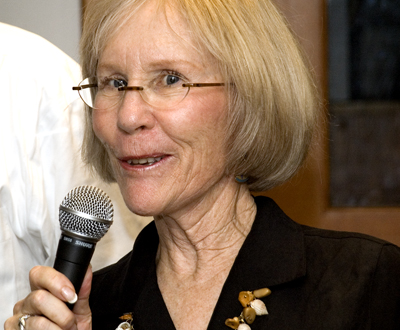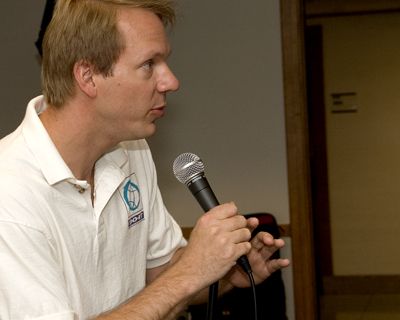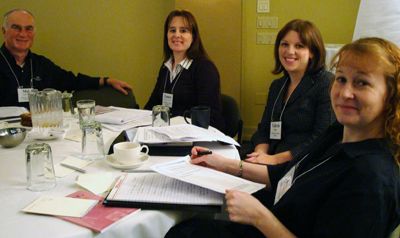Presentation Tips
Prepare
"The mind is a wonderful thing. It starts working the minute you're born and never stops working until you get up to speak in public." (Unknown)
The quality of your presentation is most directly related to the quality of your preparation. Rarely will you have difficulties in your presentation due to being overprepared.
- If you are responsible for the promotion of your presentation, create an accurate, but inviting, description. Emphasize the relevance of the content to the audience.
- Include a statement in promotional materials on how participants with disabilities can obtain disability-related accommodations for the presentation. This statement will provide an example that may be adapted by participants to use in their own publications.
- Believe in the importance of your message.
- Visualize yourself giving a great speech.
- Organize your material in a way that is most comfortable to you by using a script, outline, notes, or 3 x 5 cards. Number them.
- Proofread all printed materials.
- Practice, practice, practice—by yourself or with someone. During practice sessions you can work out the bugs and add polish to your presentation. (Note: a rehearsal usually will run about 20% shorter than a live presentation; adjust your content accordingly.)
- As participants enter, consider providing them with 3 x 5 cards and asking them to write at least one question they have about the topic of the presentation. Read them silently as people settle in. Address the questions throughout the presentation and/or at the closing.
- Have a backup plan for delivering the presentation if all of your audiovisual materials become unavailable. Do not rely on technology to work.
- Test all audiovisual equipment. Practice using your presentation slides and other visual displays. If you are using a video, make sure it is set to the correct beginning point, at the appropriate volume and with captions turned on.
- Check the lighting. If you need to adjust it during your presentation, practice the adjustments before you begin. Consider showing someone else how to make the adjustments for you.
- Have a glass of water available for yourself.
- Think about questions that might be asked and rehearse brief, clear answers to each.
- Memorize the first few minutes of your presentation.
- Review your main points.
- Dress for success.
Create a Comfortable Learning Environment
"More important than the curriculum is the question of the methods of teaching and the spirit in which the teaching is given." (Bertrand Russell)
- It is important to create a learning environment that is comfortable and welcoming.
- Arrive early and get a feel for the room, including its temperature, size, and overall set-up. Re-arrange furniture as needed.
- Warmly welcome participants, use eye contact and a welcoming posture, and thank participants for coming.
- For smaller groups, ask them to introduce themselves and indicate what they hope to learn. For larger groups, poll the audience, asking them to respond to questions related to your topic. For example, ask the audience, "How many of you have had a student with a learning disability in your class?" and then ask one individual to elaborate.
- Create a safe and nonthreatening environment where participants are not afraid to ask questions. Encourage them to share experiences and ask questions of you or other participants.
- Emphasize that everyone can contribute to the learning process.
- Clearly identify the objectives at the beginning of the session.
- Keep to the time schedule, but show that you value participant input by not rushing.
- Frame questions so that they are easy to understand.
- Do not criticize or allow audience members to criticize other participants.
- Maintain confidentiality and ask the audience to respect the privacy of other participants.

Manage Your Anxiety
"There are two types of speakers. Those who get nervous and those who are liars." (Mark Twain)
Nervousness before a talk or workshop is healthy. It shows that your presentation is important to you and that you care about doing well. The best performers are nervous prior to stepping on stage. Below are suggestions for assuring that anxiety does not have a negative impact on your presentation.
- Use nervousness to your advantage—channel it into dynamic energy about the topic.
- Remind yourself that you and the audience have the same goal, and, therefore, they want you to succeed as much as you do.
- Speak about what you know. Keeping your presentation within the realm of your knowledge and experience will build confidence and minimize nervousness.
- Focus on delivering your message, not on how you feel.
- Smile. Be relaxed, poised, and at ease on the outside, regardless of how you feel internally. Acting relaxed can help make you relaxed.
- Keep presenting! Your anxieties decrease the more presentations you give.
Create a Strong Beginning
"The greatest talent is meaningless without one other vital component: passion." (Selwyn Lager)
Keep your opening simple and exciting to engage your audience in your content.
- Consider using a short icebreaker activity.
- A tasteful, humorous commentary can be effective if related to the topic.
- Explain the purpose of your presentation in one sentence that is free of professional jargon and emphasizes what participants will gain.
- Start off with a natural pace—not too fast and not too slow—to establish a strong, positive image. Make a strong ending statement that reinforces the objectives of the presentation.
Incorporate Universal Design Principles
"I hear and I forget. I see and I remember. I do and I understand." (Confucius, 451 BC)
Model accessible teaching methods that your participants can use. Incorporate universal design principles to address the needs of participants with a wide range of knowledge, abilities, disabilities, interests, and learning styles. Examples are listed below.
- Use large fonts in your visuals. Make copies of slides available for participants.
- Be prepared to provide your materials in an alternate format, which may include electronic text, audio recording, large print, or Braille.
- Show captioned videos. If not available, provide a transcription of the content upon request.
- Arrange for a sign language interpreter if requested by a participant.
- Use a clear, audible voice. Use a microphone as needed. Face the audience at all times.
- Make sure the room is well-lit.
- Use multimedia in your presentation, such as videos, visual aids, props, and handouts.
- Demonstrate how to speak the content presented on slides and other visuals. For example, verbally describe graphs and cartoons.

Create a Dynamic Presentation
"It is the supreme art of the teacher to awaken joy in creative expression and knowledge." (Albert Einstein)
If your audience enjoys and remembers your presentation, it is because you presented it in a dynamic or compelling manner.
- Talk to your audience, not at them.
- Project enthusiasm for the topic without preaching. The majority of communication is nonverbal, so how you look and sound are vital.
- Present your material in a well-organized manner. However, be flexible to adjust to your audience. Let participants know if you wish to field questions during or after your presentation.
- Speak to the knowledge level of your audience. Define all terms they might not be familiar with.
- Choose your major points carefully and illustrate them with examples or stories.
- Incorporate real-life experiences into your presentations. Recruit students with disabilities or faculty to share their experiences. Ask audience members to share experiences and use these examples to illustrate key points or to answer questions.
- Role-play interactions between students and professors.
- Use natural gestures and voice inflection to add interest to your presentation.
- Address different learning styles by incorporating a variety of instructional methods that use a variety of senses (e.g., visual, auditory, kinesthetic).
- Repeat questions participants pose to ensure that the entire audience hears and understands them.
- Redirect the discussion if it strays from the topic at hand.
- Postpone questions related to resolving specific or individual problems to private discussions later. Do not get locked into an extended dialogue with one person; move on to questions from other participants and offer more time to talk after the presentation.
- If people ask questions that you cannot answer, say that you will locate the answer and get back to them (and then do!), suggest appropriate resources that will provide the answer, or ask for suggestions from members of the audience.
- Give demonstrations.
- Never apologize for your credentials or your material.
- Tailor your topic to audience interests.
- Never read your presentation word for word.
- Talk clearly and in well-modulated tones. Avoid speaking too rapidly, softly, or loudly. Make sure that the ends of your sentences don't drop off.
- Maintain eye contact. It conveys confidence, openness, honesty, and interest. It also lets you know how the audience is responding to your presentation. In large groups, mentally divide up the room into sections, and then make eye contact with different people in each section on a rotational basis.
- Use hand gestures naturally, gracefully, and to emphasize points. When not gesturing, let your hands drop to your sides naturally. Keep them out of pockets, off your hips, or behind your back. Avoid fiddling with clothes, hair, or presentation materials.
- Maintain good posture, but do not be rigid.
- Occasionally move from one spot to another, stop, then continue to speak. Don't pace.
- Remember that adult learners have a wealth of experience; are goal oriented and appreciate outcomes more than process; have set habits, strong tastes, and little time to waste; have strong feelings about learning situations; are impatient in the pursuit of objectives, and appreciate getting to the point; find little use for isolated facts and prefer application of information; and have multiple responsibilities, all of which draw upon their time and energy.
Make Your Presentation Interactive
"It is better to know some of the questions than all of the answers." (James Thurber)
Avoid simply lecturing to your audience. Engage your audience in an active discussion.
- Listen attentively before responding to questions.
- Encourage interactions between audience members.
- Present an accommodation challenge and ask audience members how they would address the issue.
- Respectfully reflect back to people what you observe to be their attitudes, rationalizations, and habitual ways of thinking and acting.
- Allow plenty of time for questions. Address all questions within your presentation or direct participants to appropriate resources.
- Demonstrate or provide hands-on experiences with assistive technology.
- Give useful or entertaining prizes for responses from the audience or have a drawing for a larger prize at the end of the presentation.
- If your audience is small, ask members to identify themselves and their
- experiences and interests related to the topic.
- Involve the audience in a learning activity. People remember more of what you teach them if they are able to learn it via an activity.
- Ask audience members how they have used specific accommodations or worked with students with specific disabilities. Ask questions like, "Has anyone done this? How did it work for you?"
- Stimulate group interaction and problem-solving.
- Promote discussion to help participants integrate themes and key points.
Include a Group Activity
"Real prosperity can only come when everybody prospers." (Anna Eleanor Roosevelt)
Include a short activity that makes an important point and encourages participation and discussion. Here's one to try. Announce that you're going to have a five-minute activity, then ask your participants to choose someone sitting nearby and share with each other two things:
- One thing you are very good at.
- One thing you are not very good at.
Have the instructions written on a presentation slide or write them on a flip chart. Read the instructions aloud. Give participants three to four minutes (there will be a lot of laughter and lighthearted talk), and then say you're not really interested in what they do well; ask people to share things that their partner does not do well. (This usually ends up funny—participants enjoy sharing that he can't do math, he hates public speaking, she's not good at fixing things around the house.)
After the fun, make the point that, "You have experienced, in a small way, what a person with an obvious disability experiences all the time—that people first notice something they are not particularly good at (e.g., walking, seeing, hearing) and don't take the time to learn his or her strengths. A disability may impact 10% of a person's life, yet is considered a defining characteristic by others. We need to pay attention to what everyone, including those with disabilities, can do, rather than accentuating what they can't do." To emphasize the point ask participants to reflect on how they felt when you said you weren't really interested in what they do well.
This activity is short, fun, and effective. It addresses the issue of attitudes, yet does not have some of the negative elements of traditional simulations that leave people feeling like having a disability is an impossible problem with no solution. This activity is also good to use when talking about internal and external barriers to success for students with disabilities, which can include lack of self-advocacy skills (internal barrier), and negative attitudes or low expectations on the part of individuals with whom they interact (external barrier).

Incorporate Case Studies
"Learning is an active process. We learn by doing . . . Only knowledge that is used sticks in your mind." (Dale Carnegie)
Have participants discuss case studies in small groups. At the end of this section are sample case studies that can be used in your presentation. They are all based on real experiences at postsecondary institutions. Each case study is formatted as a handout that can be duplicated for small group discussion. On the back of each activity sheet is the full description, including the solution actually employed. This version can be used for your information only or can be distributed to the group after the initial brainstorming has occurred. Participants can compare their ideas with the resolution in the actual case.
Address Key Points
"Enthusiasm is one of the most powerful engines of success. When you do a thing, do it with all your might. Put your whole soul into it. Stamp it with your own personality. Be active, be energetic, be enthusiastic, and faithful, and you will accomplish your objective. Nothing great was ever achieved without enthusiasm." (Ralph Waldo Emerson)
Be sure that your presentation covers the most important content for your audience.
- Explain the legal requirements regarding accommodating students with disabilities in clear, simple terms. Make it clear that legislation, such as the ADA, provides broad statements about accessibility, but our judicial system ultimately decides what is legal or illegal in a specific situation.
- Explain the rights and responsibilities of students with disabilities, faculty, and the disabled student services office.
- Describe specific situations that have occurred on your campus, including what was successful and situations that could be improved, and how.
- Demonstrate low-tech and high-tech accommodations, including adaptive computer technology.
- Explain how accommodations that are useful to students with disabilities can also benefit all learners.
- Provide information on campus-specific resources and procedures.
Provide Resources for Participants to Keep
"The philosophers have only interpreted the world in various ways; the point, however, is to change it." (Karl Marx)
Make sure that you provide your audience with information on which they can follow up after your presentation.
- Provide written materials of key content for future reference.
- Provide contact information and invite participants to contact you with questions after the presentation. Distribute business cards.
- For further exploration refer participants to The Faculty Room and to the Center for Universal Design in Education.
Conclude with a Strong Ending
"The greatest good you can do for another is not just to share your riches but to reveal to him his own." (Benjamin Disraeli)
The most important and remembered words you speak are the last ones.
- Summarize key points.
- Consider concluding with examples that show the importance of providing educational opportunities for students with disabilities. One idea is to have an alumnus with a disability discuss how they navigated your campus, worked with the disability services office, received the accommodations they needed, graduated with a degree, and went on to succeed in employment.
- Empower your audience to use information you presented to improve access for and education of all students with disabilities.
Improve Each Presentation
"I have the simplest tastes. I am always satisfied with the best." (Oscar Wilde)
Take steps to gain feedback about your presentation that will lead to improvements.
- Practice your presentation with colleagues or friends and ask for their feedback.
- Record your presentation for self-analysis.
- Evaluate your presentation through an anonymous written survey. Two examples of evaluation instruments are included on pages 188-190.
- Incorporate suggestions into subsequent presentations.
Conclusion
"When you can do the common things in life in an uncommon way, you will command the attention of the world." (George Washington Carver)
In summary, to give effective presentations where participants gain valuable information in a dynamic way, make sure to:
- prepare well in advance
- incorporate universal design principles
- facilitate interaction, sharing of experiences, and creative problem?solving within the session
- promote a welcoming and non?judgmental learning environment